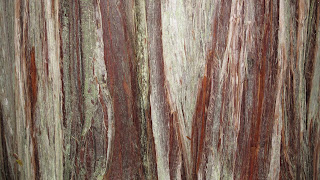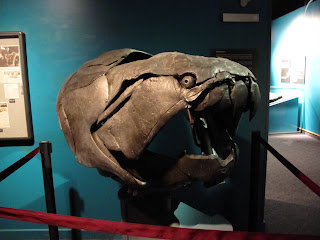One of the six rainbows that I caught on the 28th of Sept.

Looking down the Bow on a blustery, but pretty day.

This is probably one of those trips that can be described as a trip of a lifetime. I certainly had a good time and learned from a very good, friendly guide, but I have had better days catching fish at a mountain lake. One of those no name lakes. Really. The lake does not have a name.
I contacted BowRiverFlyFishing.com to set up a trip. The cost was $495 (Canadian) for a full day guided trip. With transportation and license the trip cost $590 U.S. Probably not worth the cost, but I can't complain about the excellent guide and his professionalism. He put me on the fish in terrible conditions.
When J and I arrived at Canmore I called to tell Doug Massig I was ready to go on the scheduled day of Wednesday and gave them my local phone number. Doug, owner of the guiding company, returned my call Sunday night and told me that cold weather was coming in. I knew that from watching the televised weather reports. Wouldn't you know it, they were having unseasonably warm weather in the mid-80's the week before and catching lots big fish. How many times have we fished the lake or river with little luck and meet a guy who tells us, "Man, you should have been here yesterday!"? I can't count the times. I agreed to go the next day because the guide was available and we might beat some really bad weather later in the week. Hah!!!
As it happened the guide lived within one block of the condo we were staying for the week. He picked me up at 8 and we had an hour plus drive to Calgary where I bought a fishing license and some fly tying materials that are not available in the U.S. 'Nough said on that matter. The guide and I saw eye to eye on any matter of political and social issues so we had a very pleasant conversation through out our 14 one half hours together.
We put into the river just downriver from Calgary and all seemed well. We dressed for the cold, but it never got unbearably cold. A minute later the winds came up. He was told by the lady who runs the shuttle service that the winds were from the SE. I said that where I lived that was not good news. How about here in Alberta? He said, "Not good news." We had not gone but a few hundred feet when the winds became fierce and it was all but impossible to cast a fly let alone the three flies and a bobber (ooops, dang, I keep forgetting---a strike indicator). with all my upper body and arms I could get the flies out about fifteen feet. Forget about form and technique and looking cool while letting the rod do the work. The next morning I was stiff, sore, and tired from the effort.
Curtis, who has guided for 13 years on the Bow, asked me to sit down after a mile on the river. (We would cover 25 miles by the end of the day.) The wind was so strong that he could not control the boat or even make headway with me standing up like a big sail. That was alright with me because standing more than an hour is hard on my back. There are leg braces at the bow and stern of the drift boats and the fisherman is expected to stand while fishing. But not today.
The wind was so strong that if Curtis was not rowing, we were blown up stream and this is not a gentle, lazy river of the type one might find in Georgia. On one wide spot the wind kicked up two foot high waves. There were white caps on the river throughout the day. Curtis said that it was the worst he had ever seen and he even developed a blister and this after rowing 80 trips that year. I really appreciated the guide's expertise because he constantly had me on fish, seven of which I managed to hook and lose because I did not play them well, but I did land six rainbows and one brown trout. They ranged between 19'' to 13". I probably missed several because I just did not get the hook set quick enough. Curtis would yell, "Set the hook." I would, but too late, or I hooked weeds. The wind was churning the water so much that weeds were torn loose from the bottom and were churning through the current. About every third cast (if you can call my efforts such), Curtis would call for a weed check and there almost always were weeds that had to be cleaned off at least one of the hooks. One funny part about the trip was trying to keep "river left" and "river right" straight. Curtis explained to me what I already know from river rafting that when he says cast left he is meaning on the left side of the boat as we face downstream while moving downstream with the current. Simple enough. But, because the wind was so terribley strong, Curtis had to row with the bow upstream so that he could get his back into the oars. So now I am facing up stream (sometimes we were even moving up stream when Curtis took a break from rowing). So he would say cast left and I would. We were moving upstream and I was facing that direction, but, of course, he meant to have me cast to the other side. Finally, we used a lot of pointing.
Curtis thought the wind might be blowing 70 to even up to 90 km/hr. We had no way of knowing for sure, but I don't think this is an exaggeration. The wind was just unbelievable.
I had a very difficult time holding onto the pole (ooops, there I go again, "rod" is the proper term while fly fishing) because the wind was so strong. At one time while I had lost my grip because of the wind, a fish (a big fish, of course) struck hard and completed the wind's efforts of knocking the rod out of my hand. I reached quickly with my left hand and was able to save the rod from going into the river, but not before the fish had made his escape.
Much later in the day we took a bladder draining break. I was just doing up my waders and reaching for my raincoat which I had stuffed into a hollow log when I see Curtis bounding over the small boulders in a dash toward the boat. I started to run also thinking the boat was being blown from the shore. Curtis had a heavy anchor and had set it so the boat was safe, but the wind had lifted the fly rot out of the boat and deposited it into the river. Curtis saved the rod, but in the excitement I forgot the raincoat. It never did rain that day, but the coat was a nice windbreaker. Anyway, Curtis had a client for the next day so he found the raincoat which had been blown out of the hollow log and returned it to me the next evening. I was lucky that he only lived a block away. What were the chances of that?
Curtis and I exchanged a favorite fly that we each. Here is the website of the guide company that I hired and a website of the Canadian Geographic magazine featuring Curtis guiding an author and photographer on a trip on the Bow through the city of Calgary.
Six of the seven fish I caught were caught on a small, brown San Juan River worm. The other was caught on a Bow River Bugger.








 I
I 










































